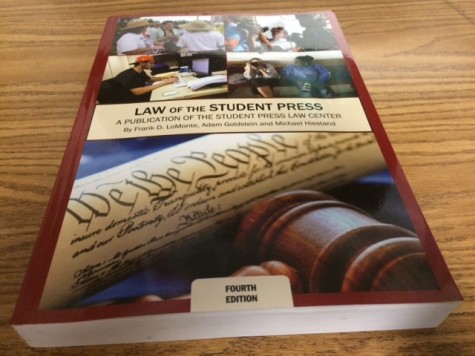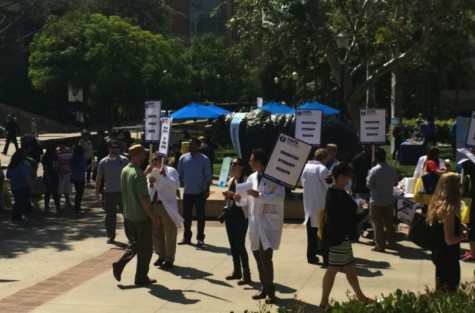Know Your Rights: The Five Freedoms
UPDATED 4/24/15: Video added. UPDATED 4/28/15: Translations updated for clarity.
April 23, 2015
America: home of the free? We are often told from a young age that America is a nation of liberty, and that as people, we have certain rights guaranteed to us in the Constitution. The most prominent of these rights are freedom of speech, religion, press, peaceful assembly, and petition. However, many people are not aware that these rights can be legally restricted in public schools.
The parameters of students’ right to free speech in public schools are based on a few landmark cases. In 1969, when a school in Des Moines Iowa prohibited students from wearing black armbands in protest of the Vietnam War, two students sued their school for violating their constitutional right to free speech.

This case, Tinker v. Des Moines Independent School District, established the standard that school administrators can not suppress a student’s right to free speech simply because the administrators disagree with the student. Instead, the court ruled that in order for a school to suppress free speech, the speech must pose as a threat to the rights of other students or as a disturbance to the school environment.
Considering that the “speech” in this case was a black armband, which the courts considered to be “symbolic speech,” this standard can be applied to school dress codes as well. School administration has the legal right to censor the clothing of students if they feel that the words expressed on the clothing item present a disturbance to the school environment.
Free speech can also be restrained in public schools because of its vulgar or inappropriate nature. The Supreme Court ruled in the 1986 case, Bethel School District No. 403 v. Fraser, that speech must fall into the appropriate parameters. These guidelines prohibit vulgarity and give school administrators the right to censor what they think is inappropriate, whether it be speech or dress. However, as Justice Oliver Wendell Holmes stated in the 1929 case United States v. Schwimmer, “If there is any principle of the Constitution that more imperatively calls for attachment…it is the principle of free thought–not free thought for those who agree with us, but freedom for the thought that we hate.” Essentially, freedom can not be restricted based on personal opinion.
The First Amendment also protects the freedom to practice any religion without fear of government interference. The current laws for religion in schools have been established through two major cases.
Engel v. Vitale, 1962, was a case in which the Supreme Court struck down a law that required New York schools to begin their school day by reciting the Pledge of Allegiance and a supposedly non-denominational prayer. Even though the law allowed students to refrain from participating, the Supreme Court found that state-sponsored school prayer still violated the Establishment Clause of the First Amendment, which states that “Congress shall make no law respecting an establishment of religion, or prohibiting the free exercise thereof.”
Essentially, at a state funded school, students can not be led in any form of prayer because it may be viewed as the state promoting a religion. However, “moments of silence” are not prohibited by the constitution because they are not associated with any specific religion.

Local doctors utilize their right to protest at a rally for student health on the UCLA campus on April 11.
Additionally, as part of the First Amendment, students are allowed to express and share their religion so long as it does not infringe upon the rights of others. Students who choose to pray at school individually or in a group are constitutionally allowed to do so as long as the action is not disruptive to the school environment or offensive to other groups. Protections for religious expression also allow students in high school to create their own clubs and groups on campus that are centered around a specific religion. However, this law does not apply to middle or elementary schools because the children are viewed as “impressionable” and “less independent.”
Although often overlooked, freedom of press is an essential right that can also be restricted in public schools. The Supreme Court case Hazelwood School District v. Kuhlmeier established that schools have reasonable discretion to censor speech that is public and school-sponsored. This decision came when three students sued their school district after their principal deleted their articles about teen mothers from the school paper because he believed the articles advocated teen pregnancy and divorce. The court found that the principal was justified in his position, and that schools can censor free speech if it is a reflection of the school and “might reasonably be perceived to advocate drug or alcohol use, irresponsible sex, or ‘conduct otherwise inconsistent with the shared values of a civilized social order,’ or to associate the school with any position other than neutrality on matters of political controversy.” This case created controversy because the ruling could be broadly interpreted, however schools administrators rarely limit free speech unless absolutely necessary.

Without the right to peaceably assemble students would not be allowed to create clubs that center around a religious or political belief, such as the Gay Straight Alliance or the Gender Equality Club. (Pictured from left to right: Emma Brown, Camille Leach, Madison Katona, Laytyn MacKinnon, and Kyle Howard.)
The rights to peaceably assemble and petition the government are also protected by the First Amendment, but since the school does not necessarily count as a government body, the freedom to petition is not firmly upheld in public schools. However, freedom of assembly applies to public schools through the means of various student led clubs and groups. The Equal Access Act, passed by Congress in 1984, allows high school students to establish a club or organization without fear of interference from the school based on their own personal religious or political views.
When school officials denied Bridget Mergens the right to create a Christian Club at her school, the Supreme Court ruled that Mergens was given permission to establish the club through the Equal Access Act, and that this did not encroach on the separation of church and state as stated in the Establishment Clause of the First Amendment. Therefore, students are allowed to create clubs without fear of discrimination by school officials. Teachers, however, are not allowed to participate in religiously or politically based clubs because they are employed by the state and must also follow the rules set in the Establishment Clause.
Furthermore, when the school allows one group to establish a club or organization, they must allow other groups to organize, even if they disagree with the group’s beliefs. This has become a common occurrence as LGBT student groups struggle to find recognition in schools.
Our five freedoms secured by the First Amendment are not guaranteed in public schools. However, this does not mean that students have no rights. Rather, based on many Supreme Court decisions, the ability of school officials to restrict some aspects of the five freedoms allows students to learn in an environment that is safe and healthy. As Kay Granger puts it, “Human rights are not a privilege granted by the few, they are a liberty entitled to all, and human rights by definition, include the rights of all humans, those in the dawn of life, the dusk of life, or the shadows of life.”
